
Tirana is the capital and largest city of Albania. It is located in the centre of the country, enclosed by mountains and hills with Dajti rising to the east and a slight valley to the northwest overlooking the Adriatic Sea in the distance. Due to its location at the Plain of Tirana and the close proximity to the Mediterranean Sea, the city is particularly influenced by a Mediterranean seasonal climate. It is among the wettest and sunniest cities in Europe, with 2,544 hours of sun per year.
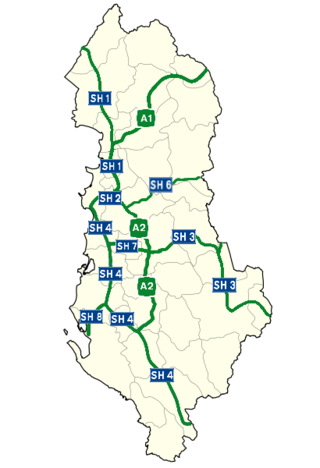
Transport in Albania consists of transport by land, water and air, which are predominantly under the supervision of the Ministry of Infrastructure of Albania. The development and improvement of the transport in the country remains among the most important priorities of the Government of Albania.
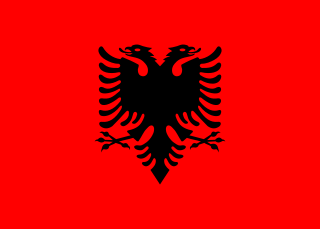
The flag of Albania is a red flag with a silhouetted black double-headed eagle in the center. The red stands for bravery, strength, valour and bloodshed, while the Eagle represents the sovereign state of Albania. The flag was established as the national flag of Albania when the country gained its independence from the Ottoman Empire in 1912.

Kavajë is a City and municipality centrally located in the Western Lowlands region of Albania, in Tirana County. It borders Durrës to the north 17 km (11 mi), Tiranë to the east 27 km (17 mi) and Rrogozhinë to the south 15 km (9 mi). To the west lies the Adriatic Sea. Based on the 2011 Census, the municipality had a population of 40,094 inhabitants, although the Civil Registry inferred the total number of inhabitants to be 79,556. The overall surface area is 199.00 square kilometres (76.83 sq mi).

The coat of arms of Albania is an adaptation of the flag of Albania and is based on the symbols of Gjergj Kastrioti Skanderbeg. It features the black double-headed eagle, documented in official use since 1458, as evidenced from a sealed document uncovered in the Vatican Secret Archive, addressed to Pope Pius II and co-sealed by notary Johannes Borcius de Grillis. The stylized gold helmet is partially based on the model of crown-like rank that once belonged to Skanderbeg, currently on display at the Kunsthistorisches Museum in Vienna, first mentioned in 1593 in the Ambras armory inventory and depicted in 1601/03 in the "Armamentarium Heroicum" of Jakob Schrenck von Notzing. The ruler of Austria, Ferdinand II, acquired the helmet from the Duke of Urbino, so mentioned in a letter sent to him from the duke, dated 15 October 1578.

Tirana County, officially the County of Tirana, is a county in the Central Region of the Republic of Albania. It is the tenth largest by area and the most populous of the twelve counties, with more than 912,000 people within an area of 1,652 km2 (638 sq mi). The county borders on the Adriatic Sea to the west, the counties of Durrës to the northwest, Dibër to the northeast, Elbasan to the east and Fier to the southwest. It is divided into five municipalities, Tirana, Kamëz, Kavajë, Rrogozhinë and Vorë, with all of whom incorporate twenty-nine administrative units.
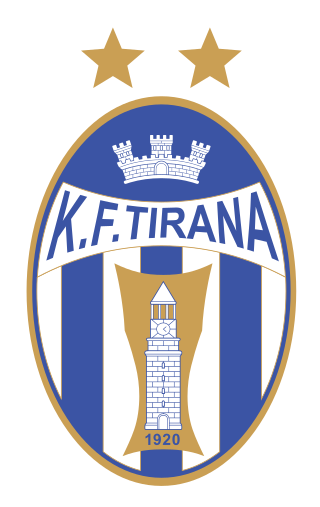
Klubi i Futbollit Tirana is an Albanian professional football club based in the country's capital city, Tirana. The men's football club is part of the multi-disciplinary sports club SK Tirana, and is the most successful in Albania, having won 54 recognized major domestic trophies. They are the only football club in Albania with two stars in their crest after winning the 20th championship in 2003, each star corresponds to ten championships. Making them the first and only Albanian club to have achieved such a feat. They play their home games at the Selman Stërmasi Stadium in Tirana and they play in the Kategoria Superiore.

The double-headed eagle is an iconographic symbol originating in the Bronze Age. A heraldic charge, it is used with the concept of an empire. Most modern uses of the emblem are directly or indirectly associated with its use by the late Byzantine Empire, originally a dynastic emblem of the Palaiologoi. It was adopted during the Late Medieval to Early Modern period in the Holy Roman Empire, Albania and in Orthodox principalities, representing an augmentation of the (single-headed) eagle or Aquila associated with the Roman Empire. In a few places, among them the Holy Roman Empire and Russia, the motif was further augmented to create the less prominent triple-headed eagle.
Dajt is a former municipality in the Tirana County, central Albania. At the 2015 local government reform it became a subdivision of the municipality Tirana. The population at the 2011 census was 20,139. The municipal unit took its name from the Mount Dajt.

The Clock Tower of Tirana, was built in 1822 in Tirana, Albania by Et'hem bey Mollaj, a Bejtexhinj poet who also finished the Et'hem Bey Mosque next to the clock tower. Watchmaster Ismail Tufina was the first to assemble the Tirana clock mechanism in 1822. It is a monument of culture of first category, approved on 24 May 1948.

Sadik Kaceli was an Albanian artist. He studied in Paris at the École nationale supérieure des Beaux-Arts (1936–1941). Kaceli is one of Albania's best known painters, receiving many decorations as People's Artist of Albania and the Honour Citizen of Tirana medal. He created the first series of the Albanian lek. In 2016 Sadik Kaceli was given the Honour of Nation Order. He is one of the founders of the National Art Gallery of Albania, designed the first version of the Albanian lek, and made the People's Republic of Albania Coat of Arms.

The national emblem of North Macedonia depicts two curved garlands of sheaves of wheat, tobacco leaves and opium poppy fruits, tied by a ribbon decorated with embroidery of traditional Macedonian folk motifs. In the center of the ovoid frame are depicted a mountain, a lake and a sunrise. The features of the national coat of arms contain a rising sun which symbolizes freedom, the Šar Mountains with its peak named Ljuboten or Mount Korab and the river Vardar, with Lake Ohrid. The emblem also contains opium poppy fruits; this poppy was brought to the area during Ottoman times in the first half of the 19th century. Until 16 November 2009, the emblem also depicted a socialistic five-pointed star in the top. The national parliament adopted the proposal to remove this element with 80 votes in favor and 18 against. This emblem had been in use since 1946, shortly after the republic became part of Yugoslavia.
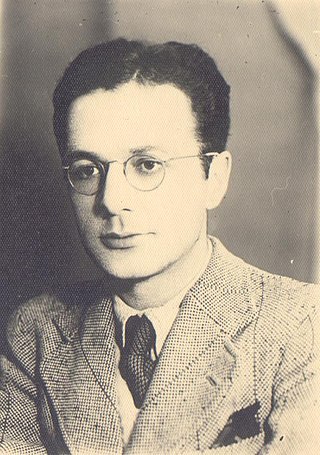
Dhimitër Shuteriqi was an Albanian scholar, literary historian, and writer. He participated in the anti-fascist National Liberation Movement. After the war he was a member of the People's Assembly and one of the founders and later president of the Albanian League of Writers and Artists. In addition to a series of books and novels, he has published numerous volumes of textbooks, especially those of the History of Albanian Literature for high schools.
The national symbols of Albania are symbols that are used in Albania to represent what is unique about the nation, reflecting different aspects of its culture and history. The symbols may also be used in the Kosovo, North Macedonia, Montenegro, Greece (Chameria), Serbia and by the Arbëreshë in Italy.
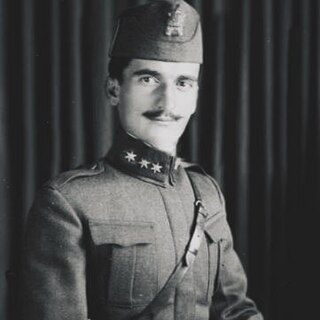
Prenk Pervizi was an Albanian military figure, General of the Albanian army, who also served as Minister of Defence for a short period during World War II. Pervizi attended the Military Academy in Vienna, Austria, from 1914 to 1918, and later in Torino, 1930–1933. As a military figure, he was a protagonist in the foreground of Albanian history in the years between 1918 and 1944. Friend and right-hand man of King Zog, he remained loyal from the beginning to the end to him and the Albanian Kingdom, 1928–1939. During World War II he was involved in military operations. Recruited by the Italians and sent to the first line of combat, he came into conflict with them, withdrawing the Albanian troops from the Greco-Italian War. He also opposed the German SS troops recruitment process in Albania. Bitter opponent of the communists, after failed attempts to engage some serious support from the British emissaries, he was forced to exile, first in Greece and later in Belgium as a political refugee. He spent the rest of his life in Belgium, where he died at age 80, on 6 September 1977.
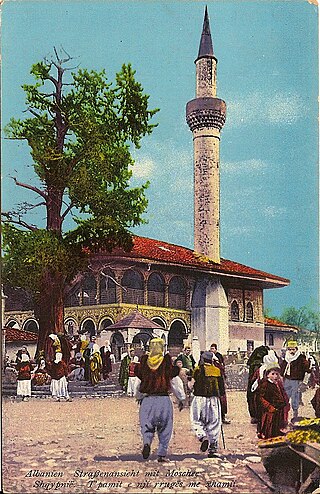
The Old Mosque or Sulejman Pasha mosque was the founding mosque of the Albanian capital Tirana. The city developed around the mosque, which was founded by the Ottoman Albanian Pasha Sulejman Bargjini along with a hamam and a bakery. In the mid of the 20th century, all of it was razed to make place for the Communist-era Unknown Soldier statue.

Albanian heraldry is the use of heraldic symbols in Albania. The earliest form of Albanian heraldry is from the late 12th century, with the creation of the first Albanian medieval state, the Principality of Arbanon in 1190. During the 13th to the 15th century, a great number of medieval Albanian noble families had at their coat of arms the symbol of eagle like the Kastrioti, Muzaka, Arianiti, Dukagjini, but the most prominent being the Kastrioti's coat of arms, having a black double headed eagle, which became a national symbol of the Albanians during Skanderbeg's reign in the 15th century, as well as the official national flag of Albania from 1912.

The Skura were a medieval Albanian feudal family centred around the historical and ethnographic region of Benda in the highlands north-east of modern Tirana, central Albania. They were among the Albanian families that rose to prominence in the Theme of Dyrrhachium and reached high military-administrative ranks within the Byzantine state apparatus. On top of their relations with the Byzantine Empire and other members of the local Albanian nobility, the Skura were also closely involved with other prominent powers in the region, such as the Angevin Kingdom of Albania and the Ottoman Empire.
Heraldry, as a scholarly discipline that deals with the study and origin of various symbols and elements, emerged in Albania towards the end of the 12th century. Over time, it has evolved as an inseparable component of European heraldry, encompassing its advancements, shifts and accomplishments.

















